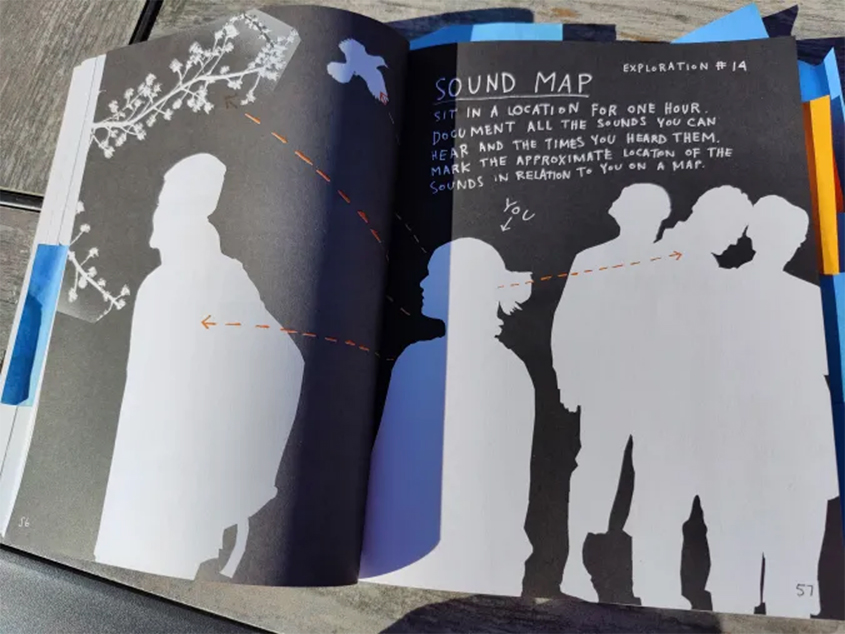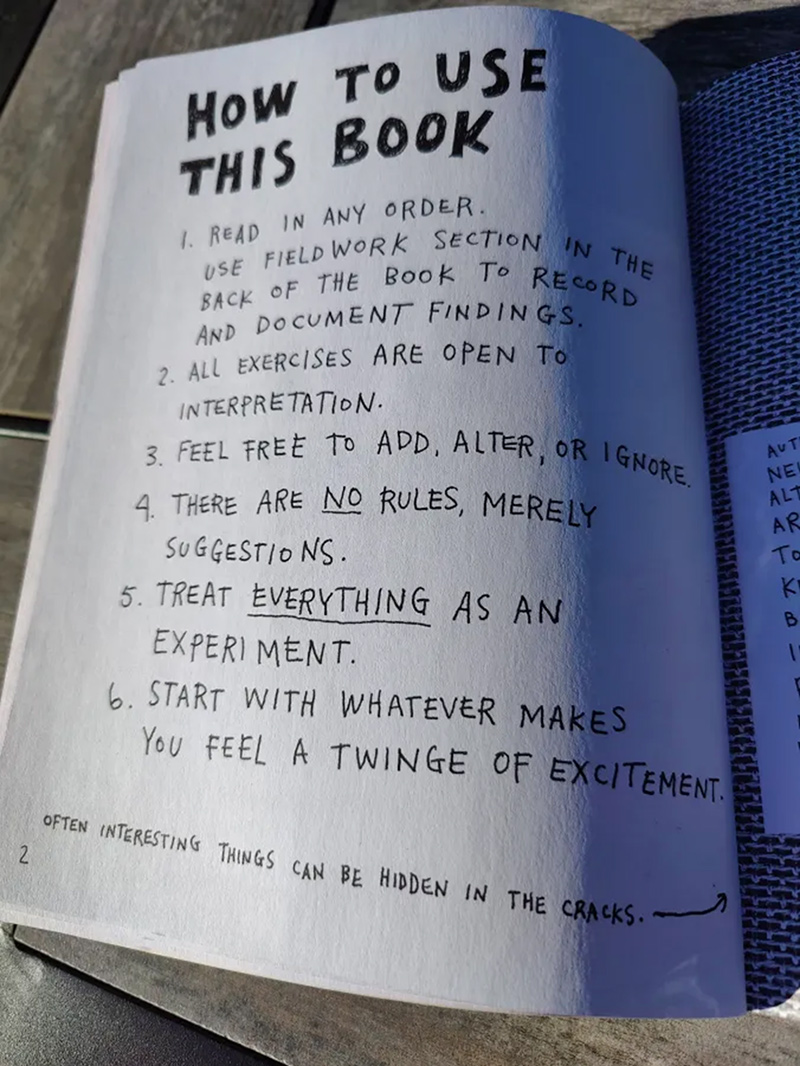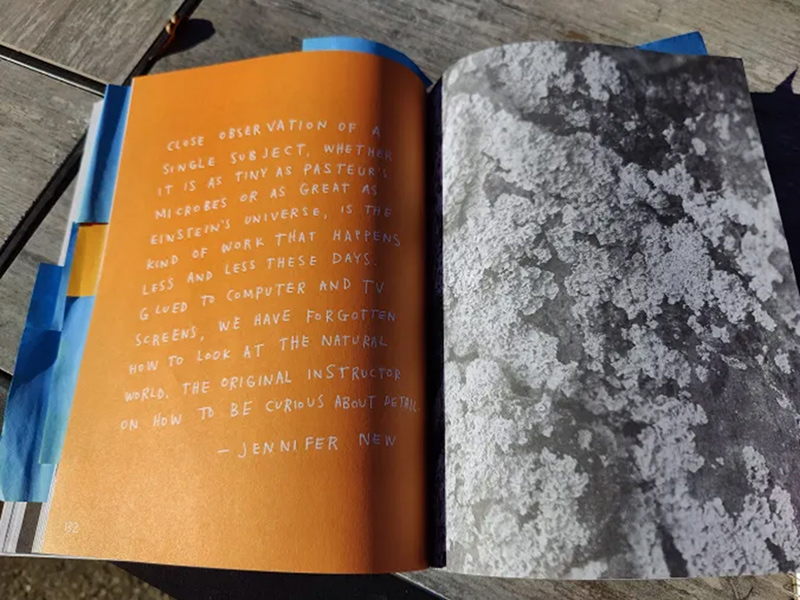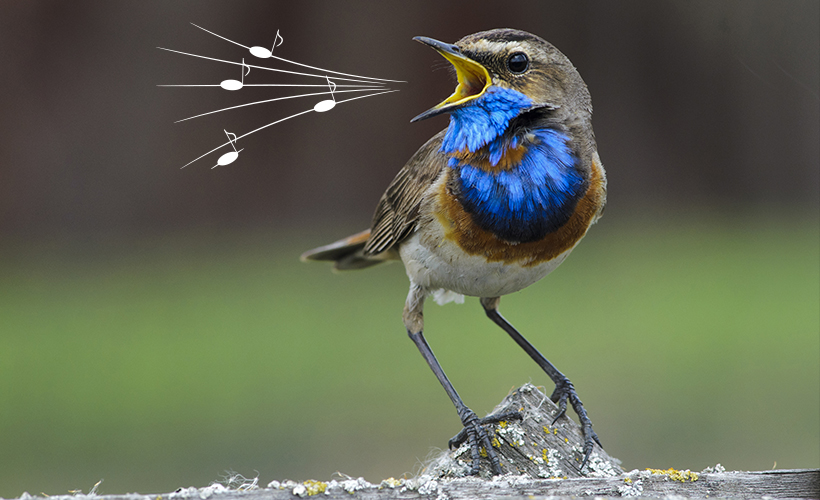One of my favorite things to do is to hang out in the backyard with the dogs. They love it because there are so many things to smell and chase, and I love it for the tranquility. We live in a suburban area in a neighborhood that’s been around long enough for the trees to be massive and the houses to look a little dated. There are several large trees (as described in one of my earlier explorations) that make homes to several types of birds and dozens of squirrels.
For my next exploration, I wanted to get back out into the backyard, into nature, and see what I could discover about my own home. After flipping through the pages of How to Be an Explorer of the World by Keri Smith while sitting at the patio table, I settled on a type of exploration I haven’t tackled yet: sound.
Exploration #14: Sound Map, Mostly

Exploration #14 asks the explorer to sit in a single location for a full hour, listening to the sounds. It says, “Document all the sounds you hear and the times you heard them. Mark the approximate location of the sounds in relation to you on a map.”
My backyard is tranquil, but quite noisy, so I thought this would be a great exploration.
However, by the fourth or fifth time that I wrote “dogs barking” within the first five minutes, I thought maybe I needed to try something else. I started to sketch a sound map, but since most of the sounds I heard originated from places around my neighborhood that I couldn’t see, I wasn’t sure exactly what to map.
But then I remembered something very important about the instructions at the beginning of this book.

Page 2 clearly states “All exercises are open to interpretation,” and “Feel free to add, alter, or ignore,” and “There are no rules, merely suggestions.”
So I decided to switch it up a bit.
I combined this exploration with #12: Fifty Things that I did several weeks ago. Instead of listing every sound for an hour, I made a list of each new sound as I heard it, the same way that I listed the things that I saw at the Farmers Market.
Lesson #1: If the rules aren’t working, change them.
I decided to do this in two phases: one early evening and one the next morning. I chose this for two reasons. The first is simply that the sounds became repetitive rather quickly when I was sitting out in the early evening, and I thought a different time of day might give me some different sounds. The second, better reason was to see the differences in the sounds between the different times of day.
Lesson #2: One set of data is good, two is better.
The Data
In the early evening, more specifically around 5 pm, I heard:
- dogs barking from at least three neighboring houses
- my two dogs barking in response
- trees rustling in the wind
- the pages of my explorer book turning
- cars driving on a nearby street
- the grill brush scraping against the grill
- a door closing at a neighbor’s house
- sirens (I think a police car and a fire truck, but I’ve never been good at identifying the different sirens)
- birds
- squirrels running through the trees
- a car door closing
- my dogs walking in the grass
- a neighbor hammering something
- my husband’s voice
- my husband playing his djembe and an electric keyboard
The next morning, more specifically around 7 am, I heard:
- birds chirping
- cars driving on a nearby street
- a school bus stopping and going
- a rooster announcing the morning
- and, just when I thought this would be the biggest difference between the times, the neighbors’ dogs barking
The Similarities
There were two big similarities, and honestly they’re both sounds that I always hear in the backyard no matter what time of day or night: the birds and the dogs. The birds were louder in the morning and the dogs were louder in the evening, but they’re both ever present.
It may seem like there are only two similar sounds between morning and evening, but those were the two most repeated sounds and the two that I most associate with my backyard, my home. It may be only two, but it’s a big two.
Lesson #3: It’s often not the quantity but the quality.
The Differences
The most obvious difference between the two lists is the length. I heard more different noises in the early evening than in the morning. The neighborhood was alive with after-work and after-school noises. At 7 am, the neighborhood is much more sleepy. No slamming doors or sirens or hammering.
There are a couple of other easily explained differences between what I heard at 5 pm and what I heard at 7 am. The first is that my husband was in the backyard cooking dinner in the evening. The grill brush, his voice, and his musical talents were only heard in the evening because he was only there in the evening. The rooster also seems like a pretty obvious morning sound that I wouldn’t expect to hear in the evening. The school bus also makes sense. 7 am is a normal time for picking up students, and 5pm is a little late for dropping them off. If my evening time had been around 3 or 4 pm, I might have heard the buses bringing students home again.
I was a little surprised that I didn’t hear (or see for that matter) the squirrels in the morning. I’d never noticed that they’re more active during the day. They must be late sleepers.
Lesson #4: Look for what you’ve never noticed before.
One difference that I’m finding difficult to put into words was the general feeling in the backyard at each time. More than simply being louder in the evening, the sounds felt more vibrant, more alive. In the morning, it felt as if the world were still sleeping. The sounds that I did hear felt more muted, more reserved. This is the kind of data that is difficult to quantify and exactly the kind of analysis that is best suited to careful qualitative inquiry.
Lesson #5: Qualitative inquiry can help describe the indescribable.
Reflection
An interesting side effect of completing this exploration this week has been in how I’ve noticed more sounds around me even when I wasn’t “collecting data.” When I took the dogs outside in the middle of the day yesterday, I noticed the familiar sounds of birds chirping and dogs barking, but then I also noticed the sound of a plane flying overhead. I thought about how on weekends I also hear the sounds of kids in the neighborhood playing. When I was sitting in my office, I noticed the sound of the water in the fish tank and of a neighbor mowing the lawn.
There’s a random page in the book that just has this quote:
“Close observation of a single subject, whether it is as tiny as Pasteur’s microbes or as great as Einstein’s universe, is the kind of work that happens less and less these days. Glued to computer and TV screens, we have forgotten how to look at the natural world, the original instructor on how to be curious about detail.”—Jennifer New

This has been my favorite aspect of completing these exercises: learning how to notice what’s happening around me. The first time I went back to the Baytown Farmers Market after completing my fourth exploration, I found myself looking at all the details around me, even though I wasn’t making a list of 50 things this time. I paid more attention to the slight differences between my visits—the booth that hadn’t been there last month, the different vendor handing out roasted pecan samples—and the similarities—the table full of mason jars with bits of colorful fabric tied on top, the table full of fresh vegetables.
Going through this process is almost making me wish I were back in a middle school classroom so that I could have my students complete some of these explorations. Perhaps over the summer I’ll contemplate how to work these into the curriculum for my EdTech undergrads, to get them thinking more deeply about their surroundings this Fall.
If you’ve been reading these posts and haven’t already, I do encourage you to take the challenge of completing a few of these explorations yourself. Pick up Keri Smith’s book from your local bookstore or library, or simply replicate the explorations I’ve done so far. I wasn’t sure what all I could get out of these activities, but I’m finding myself becoming a deeper thinker, a better researcher, and a stronger teacher.

An interesting feature of Credo Reference is one that could be easily overlooked. When searching keywords or exploring topics, there is an option just under the “Articles” tab to select the type of media. I think that, when most people think about conducting scholarly research, they think of only written sources, scholarly journals, or just generally long boring walls of text. Credo Reference highlights the multimodality of research by allowing the searcher to narrow the search by results that contain images, maps, audio, and video.
I challenge you to explore a topic that you find interesting through only sound. Narrow the search to audio and see what you can learn with only your ears. Maybe you’ll learn something new or begin to consider an old topic in a new tune.
Learn more about Credo Reference for colleges and universities and public libraries, and take a FREE TRIAL today!
Originally published on Mrs. Hebert’s Classroom on March 24, 2022. You can also listen to the podcast here:
Like this article? Check out the previous blog articles in this series:
- Learning to Be an Explorer of the World
- Exploring the World in Words
- Exploring Pointillism in My Backyard
- Exploring the Farmers Market
- Exploring Beyond My Comfort Zone
Also, check out the next blog articles in this series:
See also:


